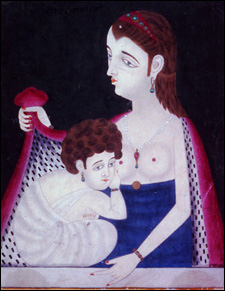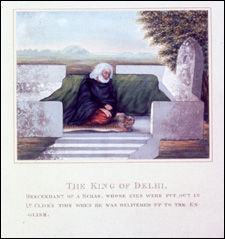East meets West in stunning exhibition:
Colonial India’s art treasures at Sackler

The arts and visual culture of colonial India will be on display at the Arthur M. Sackler Museum now through May 25. Visitors will see works ranging from paintings and fine luxury objects to documentary drawings and historical photographs that show India during the European colonization of South Asia in the 17th through early 20th centuries.
“‘Image and Empire’ allows a broad examination of the arts and visual culture produced in and about India during the colonial era,” said James Cuno, Elizabeth and John Moors Cabot Director of the University Art Museums. “It features works created by South Asian as well as Western artists and brings together materials from different area museums and collections.”
Exciting pieces in the exhibition include a small decorative box in the shape of a casket, made of ivory and wood and inlaid with gemstones, lent by Boston’s Museum of Fine Arts. The box was made in the 16th century and presented to the Portuguese royal family by the king of Sri Lanka. “Objects such as this helped drive the colonization of South Asia – Europeans wanted access to luxury goods and the spices and wealth of the East,” said Kimberly Masteller, assistant curator of Islamic and later Indian art at the Arthur M. Sackler Museum and curator of the show.

“I hope people will come away from the exhibition with impressions of the ways India was represented, and thus perceived, during the colonial era,” Masteller said. “The depictions rendered 100 or 200 years ago may have been less than accurate because an exoticism or stereotyping sometimes occurred. The objects in this exhibition have many stories to tell, not only about the art of the period but about the artists who made them and the changing world they lived in.”
The exhibition also includes the painting “Colonel Mordaunt’s Cockfight” (c. 1800), which depicts the local and British elites embattled in carnivalesque sport in colonial Lucknow. It is believed to have been painted by a Mughal-trained artist working from a mezzotint after the original painting of the same name by British artist Johann Zoffany. Also on display are a rare Rajput portrait of Queen Victoria depicted as a maharani and several important examples of “Company painting” – works by Indian artists for foreign patrons – often members of the British East India Company.
One object of great historical interest is a photo album documenting the imperial journey of Prince Edward of England to India in 1875 to mark the official passage of India into the British Empire. Another is a painting titled “The Last Mughal Emperor: Bahadur Shah II with Two Sons and a Servant” (1838). This regal portrayal stands in sharp contrast with a photograph of the frail and broken ruler after the mutiny of 1857, when he was deposed and exiled by the British.
Important loans from the Peabody Museum of Archaeology and Ethnology at Harvard include documentary oil paintings of snake charmers and a yogi by André Cheronnet Champollion (Harvard class of 1902), and a set of ethnographic figurines from the mid-19th century. In addition, figural sketches and picturesque scenery appear in several lively drawings by the English artists Thomas and William Daniell and Edward Lear, lent by Harvard’s Houghton Library. Examples of early modern painting from Kalighat and Calcutta (lent by the Peabody Essex Museum and a private collector) embody the fusion of new and traditional subjects and styles as Indian artists were informed by and responded to contemporary imagery and politics. One such work, a 1937 painting by famed Indian modernist Nandalal Bose, rejects Western styles and naturalism and instead adopts the folk style of Kalighat. ‘Image and Empire: Picturing India During the Colonial Era,’ on display at the Arthur M. Sackler Museum, now through May 25.




